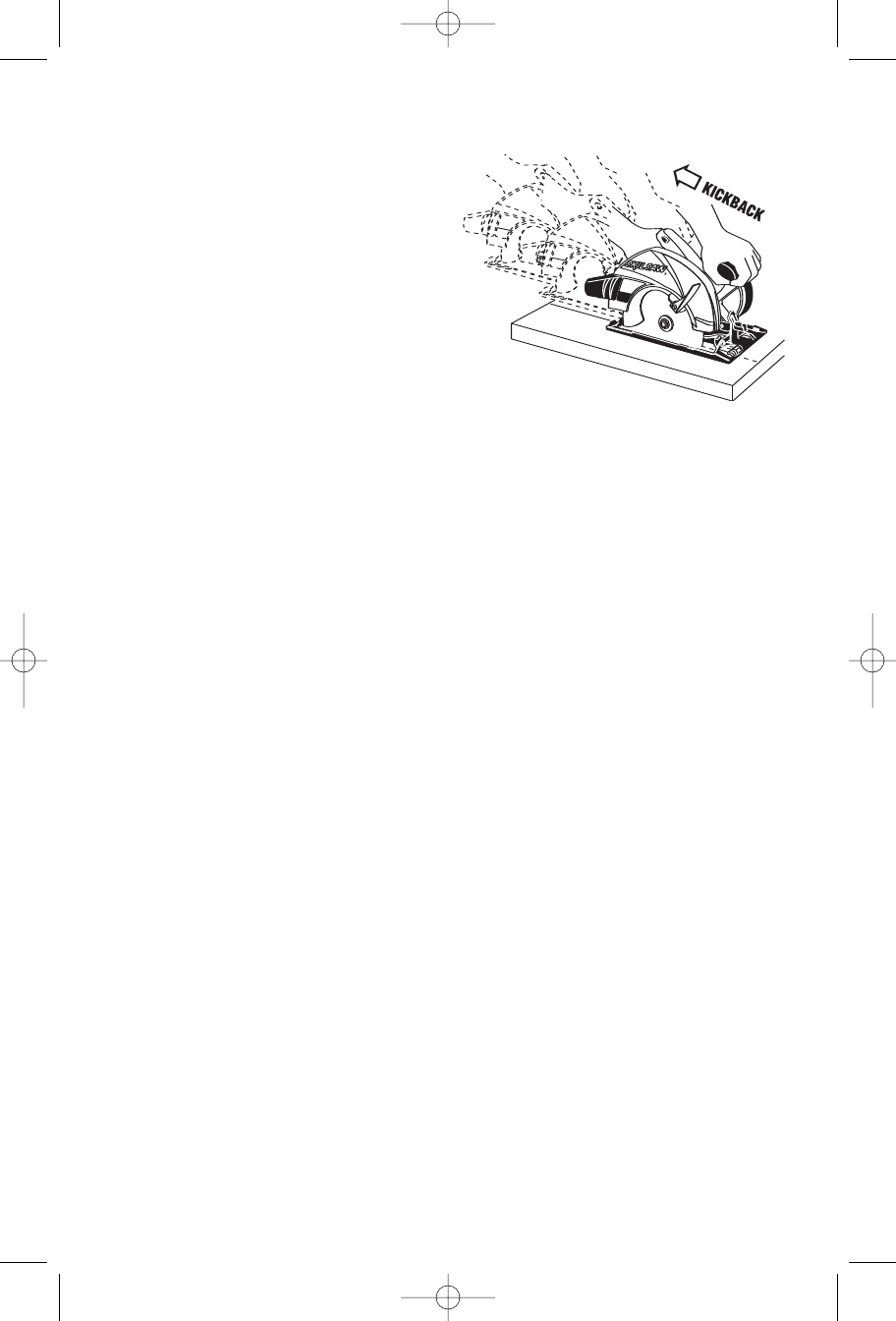
When ripping always use a rip fence or
s
traight edge guide.
T
his improves accuracy
of cut and reduces the chance for blade binding.
Always use blades with correct size and
shape (diamond vs. round) arbor holes.
B
lades that do not match the mounting
h
ardware of the saw will run eccentrically,
causing loss of control and will not allow proper
vari-torque engagement.
Never use damaged or incorrect blade
washers or bolts.
The blade washers and bolt
were specially designed for your saw, for
optimum performance and safety of operation.
The blade washers and the bolt on your saw
have been designed to work as a “VARI-
TORQUE CLUTCH”. Understand the operation
and settings of the VARI-TORQUE CLUTCH,
because the proper setting of the CLUTCH,
combined with firm handling of the saw will
allow you to control KICKBACK.
Do not run the saw while carrying it at your
side. Lower guard may be opened by a
contact with your clothing.
Accidental contact
with the spinning saw blade could result in
serious personal injury.
Depending upon use, the switch may not
last the life of the saw. If the switch should
fail in the “OFF” position, the saw may not
start. If it should fail while the saw is
running, the saw may not shut off.
If either
occurs, remove battery pack from saw
immediately and do not use until repaired.
This circular saw should not be mounted to
a table and converted to a table saw.
Circular
saws are not designed or intended to be used
as table saws.
CAUSES AND OPERATOR PREVENTION
OF KICKBACK:
Kickback is a sudden reaction to a pinched,
bound or misaligned saw blade, causing an
uncontrolled saw to lift up and out of the
workpiece toward the operator.
When the blade is pinched or bound tightly by
the kerf closing down, the blade stalls and the
motor reaction drives the unit rapidly back
toward the operator.
If the blade becomes twisted or misaligned in
the cut, the teeth at the back edge of the blade
can dig into the top surface of the wood causing
the blade to climb out of the kerf and jump back
toward the operator.
Kickback is the result of tool misuse and/or
incorrect operating procedures or conditions
and can be avoided by taking proper
p
recautions as given below:
Maintain a firm grip with both hands on the
saw and position your body and arm to
allow you to resist KICKBACK forces.
KICKBACK forces can be controlled by the
operator, if proper precautions are taken.
When blade is binding, or when interrupting
a cut for any reason, release the trigger and
hold the saw motionless in the material until
the blade comes to a complete stop. Never
attempt to remove the saw from the work or
pull the saw backward while the blade is in
motion or KICKBACK may occur.
Investigate
and take corrective action to eliminate the cause
of blade binding.
Wet lumber, green lumber or
pressure treated lumber require special
attention during cutting operation to prevent
KICKBACK. Avoid cutting nails. Inspect for and
remove all nails from lumber before cutting.
When restarting a saw in a workpiece,
center the saw blade in the kerf and check
that saw teeth are not engaged into the
material.
If saw blade is binding, it may walk up
or KICKBACK from the workpiece as the saw is
restarted.
Support large panels to minimize the risk of
blade pinching and KICKBACK.
Large panels
tend to sag under their own weight. Supports
must be placed under the panel on both sides,
near the line of cut and near the edge of the
panel.
See “Cutting Large Sheets” in this
manual.
Do not use dull or damaged blade.
Unsharpened or improperly set blades produce
narrow kerf causing excessive friction, blade
binding and KICKBACK.
Blade depth and bevel adjusting locking
knobs must be tight and secure before
making cut.
If blade adjustment shifts while
cutting, it may cause binding and KICKBACK.
-4-
SM 1619X02227 01-07 1/12/07 3:22 PM Page 4


















